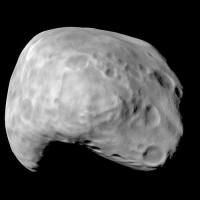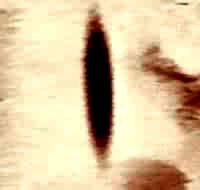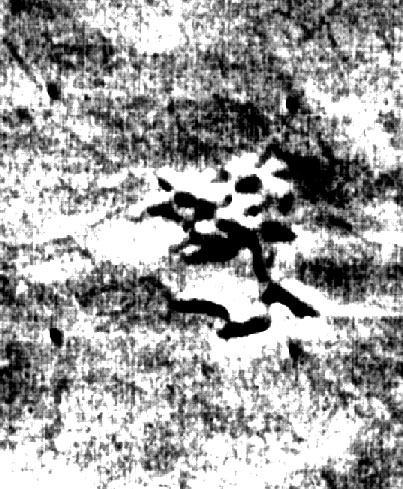|

from
DarkStar Website
|
"At most, terrestrial men
fancied that there might be other men upon Mars, perhaps
inferior to themselves and ready to welcome a missionary
enterprise."
.
H.G. Wells
War of the Worlds
 |
Phobos, one of the two moons of
Mars,
has itself always been considered a rather mysterious object, as has
its smaller twin, Deimos. Joseph Shklovskii noted member of the
Soviet Academy of science and co-writer with Dr Carl Sagan of
'Intelligent life in the universe', once calculated from the
estimated density of the Martian atmosphere and the peculiar
"acceleration" of Phobos, that the satellite must be hollow. Could
Phobos be a hollowed-out space station of huge proportions?
In July 1988, the Russians launched two unmanned satellite probes -
Phobos 1 and Phobos 2 - in the direction of Mars, and with the
primary intention of investigating the planet's mysterious moon,
Phobos. Phobos 1 was unfortunately lost en route two months later,
reportedly because of a radio command error. Phobos 2 was also
ultimately lost in the most intriguing circumstances, but not before
it had beamed back certain images and information from the planet
Mars itself.
Phobos 2 arrived safely at Mars in January 1989 and entered into an
orbit around Mars as the first step at its destination towards its
ultimate goal: to transfer to an orbit that the would make it fly
almost in tandem with the Martian moonlet called Phobos (hence the
spacecrafts name) and explore the moonlet with highly sophisticated
equipment that included two packages of instruments to be placed on
the moonlet's surface.
All went well until Phobos 2 aligned itself with Phobos, the Martian
moonlet. Then, on 28th March, the Soviet mission control center
acknowledged sudden communication "problems" with the spacecraft;
and Tass, the official Soviet news agency,
|

Deimos - "click"
to enlarge |
reported that,
"Phobos 2 had failed to
communicate with Earth as scheduled after completing an operation
yesterday around the Martian moon Phobos. Scientists at mission
control have been unable to establish stable radio contact."
What had caused the Phobos 2 spacecraft to be lost?
According to Boris Bolitsky, science correspondent for Radio Moscow,
just before radio contact was lost with Phobos 2, several unusual
images were radioed back to Earth, described by the Russian as
"Quite remarkable features". A report taken from New Scientist of 8
April 1989, described the following:
"The features are either on the
Martian surface or in the lower atmosphere. The features are
between 20 and 25 kilometers wide and do not resemble any known
geological formation. They are spindle - shaped and proving to
be intriguing and puzzling."
An unusual photo of a thin shadow across
mars (below left image) was shown on
the Russian television segment. Seen on the surface of Mars was a
clearly defined dark shape that could indeed be described, as it was
in he initial dispatch from Moscow, as a "thin
 ellipse"
(this photo is a still from the Soviet television clip). ellipse"
(this photo is a still from the Soviet television clip).
It was
certainly different from the shadow of Phobos recorded eighteen
years earlier by Mariner 9. The latter cast a shadow that was a
rounded ellipse and fuzzy at the edges, as would be cast by the
uneven surface of the moonlet.
The 'anomaly' seen in the Phobos 2
transmission was a thin ellipse with very sharp rather than rounded
points (the shape is known in the diamond trade as a "marquise") and
the edges, rather than being fuzzy, stood out sharply against a kind
of halo on the Martian surface.
Dr. Becklake described it as
"something that is between the spacecraft and Mars, because we can
see the Martian surface below it," and stressed that the object was
seen by both the optical and the infrared (heat seeking) camera.
All these reasons explain why the Soviets have not suggested that
the dark, "thin ellipse" might have been a shadow of the moonlet.
While the image was held on the screen, Dr. Becklake explained that
it was taken as the spacecraft was aligning itself with Phobos (the
moonlet).
"As the last picture was halfway through," he said, "they
[Soviets] saw something that should not be there."
The Soviets, he
went on to state, have not yet released this last picture, and we
wont speculate on what it shows.
So what was it that collided or crashed into Phobos 2? Was the space
probe shot out of space for "seeing too much"? What does the last
secret frame show? Well... Cosmic Conspiracies have managed to track
down this elusive last picture (see below
right). In his careful words to
'Aviation Week and Space Technology', the chairman of the Soviet
equivalent of NASA, referred to the last frame, saying,
"One image
appears to include an odd-shaped object between the spacecraft and
Mars."
This "highly secret" photo was later given to the Western press by
Colonel Dr. Marina Popovich, a Russian astronaut and pilot who has
long been interested in UFO's. At a UFO conference in 1991,
Popovich
gave to certain investigators some interesting information that she
"smuggled" out of the now ex-Soviet Union. Part of the information
was what has been called "the first ever leaked accounts of an alien
mother ship in the solar system".
|

The very last
picture taken by Phobos 2 |
The last transmission from Phobos 2 was
a photograph of a gigantic cylindrical spaceship - a huge, approx,
20km long, 1.5km diameter cigar-shaped 'mother ship', that was
photographed on 25 March 1989 hanging or parked next to the Martian
moon Phobos by the Soviet unmanned probe Phobos 2.
After that last
frame was radio-transmitted back to Earth, the probe mysteriously
disappeared; according to the Russians it was destroyed - possibly
knocked out with an energy pulse beam.
The cigar shaped craft in the penultimate frame taken by Phobos 2 is
apparently the object casting the oblong shadow on the surface of
Mars in the earlier photo.
Australian science writer Brian Crowley says that because of the
convex cats eye shadow - which, because the overhead solar
inclination prevented shadow-casting by Martian surface features,
implies a shadow thrown on the surface from something in orbit -
beyond the orbit of Phobos 2 itself.
The shadow - spindle- or cigar
shaped - is inconsistent with any possible shadow cast by the moon
Phobos, which is an irregular potato shape. One needs little
imagination to postulate a giant, hovering cigar- shaped mother
craft similar to those documented down the years by UFO
investigators.
INFRARED
PHOTOS OF AN UNDERGROUND CITY
Another Phobos picture, released on Canadian TV, presents an
infrared scan radiometer image of the Martian surface that showed
clearly defined rectangular areas. These are interconnected with a
latticework of perfectly straight channels, much resembling a city
block. There were no corresponding surface features taken by regular
cameras. This suggests the heat signature of what may be a set of
underground cavern or channels that are just too geometrically
regular to be formed naturally.
According to Dr. John Becklake of
the London Science Museum,
"The city-like pattern is 60 kilometers
wide and could be easily be mistaken for an aerial view of Los
Angeles."
Pressed by their international participants in the Phobos missions
to provide more definitive data, the Soviet authorities released the
taped television transmission Phobos 2 sent in its last moments -
except for the last frames, taken just seconds before the spacecraft
fell silent. The television clip was shown by some TV stations in
Europe and Canada as part of weekly "diary" programs, as a curiosity
and not as a hot news item.
The television sequence thus released focused on two anomalies. The
first was a network of straight lines in the area of the Martian
equator; some of the lines were short, some longer, some thin, some
wide enough to look like rectangular shapes "embossed" in the
Martian surface. Arranged in rows parallel to each other, the
pattern covered an area of some six hundred square kilometers (more
than two hundred thirty square miles). The "anomaly" appeared to be
far from a natural phenomenon.
The television clip was accompanied by a live comment by Dr. John Becklake of England's Science Museum. He described the phenomenon as
very puzzling, because the pattern seen on the surface of Mars was
photographed not with the spacecraft's optical camera but with its
infrared camera - a camera that takes pictures of objects using the
heat they radiate, and not by the play of light and shadow on them.
In other words, the pattern of parallel lines and rectangles
covering an area of almost two hundred fifty square miles was a
source of heat radiation. It is highly unlikely that a natural
source of heat radiation (a geyser or a concentration of radioactive
minerals under the surface, for example) would create such a perfect
geometric pattern. When viewed over and over again, the pattern
definitely looks artificial; but what it was, the scientist said, "I
certainly don't know." (Cosmic Conspiracies have written to
Dr. Becklake in the hope that we can track down this picture).
Since no coordinates for the precise location of this "anomalous
feature" have been released publicly, it is impossible to judge its
relationship to another puzzling feature on the surface of Mars that
can be seen in Mariner 9 frame 4209-75 (image
below).

It is also located in the equatorial
area (at longitude 186.4) and has been described as "unusual
indentations with radial arms protruding from a central hub" caused
(according to NASA scientists) by the melting and collapse of
permafrost layers. The design of the features, bringing to mind the
structure of a modern airport with a circular hub from which the
long structures housing the airplane gates radiate, can be better
visualized when the photograph is reversed.
We have managed to track down the final picture taken by Phobos 2
before it was "shot out of orbit" (see above). One report indicated
that it was presented at a closed meeting with US and British
officials.
In the 19th October, 1989 issue of 'Nature', Soviet scientists
published a series of technical reports on the experiments Phobos 2
did manage to conduct: of the thirty seven pages, a mere paragraph
deal with the spacecrafts loss. The report confirms that the
spacecraft was spinning, either because of a computer malfunction or
because Phobos 2 was "impacted" by an unknown object.
And so we see that it is not only NASA that is apparently involved
in suppressing photographs and knowledge of other planets, but the
Russian space program as well.
CHAIN
CRATERS OF PHOBOS
In an interesting article in the January 1977 issue of 'Astronomy',
entitled "Chain Craters of Phobos", the anonymous author discusses
the strange grooves and craters of Phobos:
"Viking has discovered another
mystery in the most unexpected place - one of the two small
Martian moons. Mariner 9's mapping of Phobos (12x14x17 miles or
20x23x28 kilometers) and Deimos (6x7x10 miles, or
 10x12x16
kilometers) showed many craters, and left most investigators
with the impression that they were merely rocky chunks that bore
the scars of meteorite impacts. 10x12x16
kilometers) showed many craters, and left most investigators
with the impression that they were merely rocky chunks that bore
the scars of meteorite impacts.
There was a puzzling feature on Phobos that a few analysts noticed but, without better data,
could say little about.
At the limit of resolution were a few small crater pits that
seemed to align in one or two chains. This was unusual, because
crater chains on the moon were traditionally explained as
volcanic pits - small eruption sites string along fracture
lines. Yet Phobos apparently is too small to generate heat and
conventional volcanic activity.
"Vikings high resolution photos have revealed that the crater
chains are real and part of an extensive system of parallel
grooves, a few hundred yards wide (shown in Viking orbiter photo
number 39B84). There may be a tendency for the grooves to lie
parallel to the direction of the satellites orbital motion,
although there appears to be several swarms with somewhat
different orientations.
Scientists are at a loss to explain
them. Theories being discussed include:
-
grooves left by much
smaller satellite debris also orbiting Mars (though the grooves
seem to follow contours of Phobos' surface to closely for this
to be tenable)
-
fractures radiating from an impact crater not
yet recognized (perhaps on the side of Phobos still poorly
photographed)
-
or fractures created in the body of the Martian
satellite when it was part of a hypothetical larger body and
that it spawned both Martian moons, perhaps during a
catastrophic impact"
In the latest effort to photograph Mars
and its moons, the NASA 'Mars Observer' was launched from Cape
Canaveral Air Force Base in Florida in late 1992, on a 337 day
voyage to Mars. The Mars Observer initially was expected to arrive
at Mars by 19 August 1993, and enter a long, elliptical orbit over
the poles. In mid November 1993 it was to begin its two year mapping
of the surface of Mars. Then suddenly, on 22nd August 1993, it was
announced that NASA had lost contact with the spacecraft.
Americans and the world mourned the loss of a valuable scientific
tool for understanding Mars. Taxpayers wondered if there was a
better way to spend their money than on expensive space probes that
didn't work. A dark shield was going up on new information about
Mars to the public at large...
According to retired Soviet Air Force Colonel Marina Popovich,
Phobos, one of the two Martian moons, is an artificial structure. In
a meeting with CSETI's International Director,
Dr. Steven Greer, she
told him that her sources also advised that it is hollow.
Interestingly, the same story was told to contacteť Paul Villa Jr.
by an ET that he had an encounter with in Long Beach, Ca in 1953.
(See "Alien Base", by
Timothy Good, P. 241)
|



 ellipse"
(this photo is a still from the Soviet television clip).
ellipse"
(this photo is a still from the Soviet television clip). 

 10x12x16
kilometers) showed many craters, and left most investigators
with the impression that they were merely rocky chunks that bore
the scars of meteorite impacts.
10x12x16
kilometers) showed many craters, and left most investigators
with the impression that they were merely rocky chunks that bore
the scars of meteorite impacts.